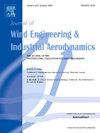Estimating peak pressure coefficients for high-rise buildings: LES-based evaluation of Gumbel and XIMIS methods
IF 4.9
2区 工程技术
Q1 ENGINEERING, CIVIL
Journal of Wind Engineering and Industrial Aerodynamics
Pub Date : 2025-07-03
DOI:10.1016/j.jweia.2025.106161
引用次数: 0
Abstract
Accurately estimating peak wind pressures is essential for the safe and cost-effective design of high-rise buildings. This study evaluates LES-based peak pressure coefficient predictions for high-rise buildings, using 1-h equivalent full-scale wind tunnel data from Tokyo Polytechnic University as a reference. The research examines the effects of segment durations, number of segments, total EFS durations, and wall-specific error analysis and prediction uncertainties in LES. The Cook-Mayne conversion standardized shorter segments to a 60-min EFS duration but introduced prediction discrepancies, particularly for negative peak pressures. Findings indicate that longer total durations with moderate segment lengths yield reliable maximum pressure predictions, while shorter segment durations are more effective for minimum pressures. Wall-specific analysis reveals greater uncertainties near the ground on side and leeward walls due to recirculation and separation, and at higher elevations on the windward wall from stagnation effects. The XIMIS method yields peak estimates comparable to the Gumbel method, effectively handles limited data. While LES shows strong potential for capturing peak pressures, its accuracy in Gumbel based analysis is sensitive to segment and total simulation durations. In contrast, XIMIS offers consistent results without need for segmentation, making it particularly valuable when data availability is limited.
高层建筑峰值压力系数估算:基于les的Gumbel和XIMIS方法评价
准确估计峰值风压对高层建筑的安全、经济设计至关重要。本研究以东京工业大学1小时等效全尺寸风洞数据为参考,评估基于les的高层建筑峰值压力系数预测。该研究考察了段持续时间、段数量、总EFS持续时间、壁特异性误差分析和预测不确定性对LES的影响。Cook-Mayne转换将较短的时间段标准化为60分钟的EFS持续时间,但引入了预测差异,特别是对于负峰值压力。研究结果表明,较长的总持续时间和中等长度的分段可以得到可靠的最大压力预测,而较短的分段持续时间可以得到更有效的最小压力预测。特定墙体的分析表明,由于再循环和分离,在靠近地面的侧面和背风墙壁上,以及在较高海拔的迎风墙壁上,由于停滞效应,存在更大的不确定性。XIMIS方法产生的峰值估计与Gumbel方法相当,有效地处理有限的数据。虽然LES显示出捕获峰值压力的强大潜力,但其在基于Gumbel的分析中的准确性对分段和总模拟持续时间很敏感。相比之下,XIMIS提供一致的结果而不需要分割,这使得它在数据可用性有限时特别有价值。
本文章由计算机程序翻译,如有差异,请以英文原文为准。
求助全文
约1分钟内获得全文
求助全文
来源期刊
CiteScore
8.90
自引率
22.90%
发文量
306
审稿时长
4.4 months
期刊介绍:
The objective of the journal is to provide a means for the publication and interchange of information, on an international basis, on all those aspects of wind engineering that are included in the activities of the International Association for Wind Engineering http://www.iawe.org/. These are: social and economic impact of wind effects; wind characteristics and structure, local wind environments, wind loads and structural response, diffusion, pollutant dispersion and matter transport, wind effects on building heat loss and ventilation, wind effects on transport systems, aerodynamic aspects of wind energy generation, and codification of wind effects.
Papers on these subjects describing full-scale measurements, wind-tunnel simulation studies, computational or theoretical methods are published, as well as papers dealing with the development of techniques and apparatus for wind engineering experiments.

 求助内容:
求助内容: 应助结果提醒方式:
应助结果提醒方式:


